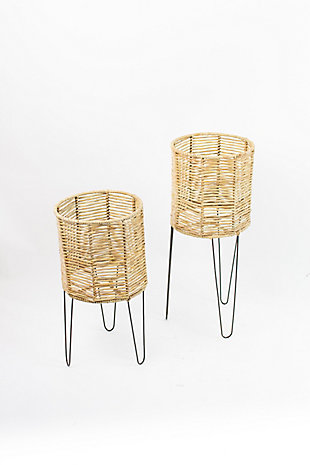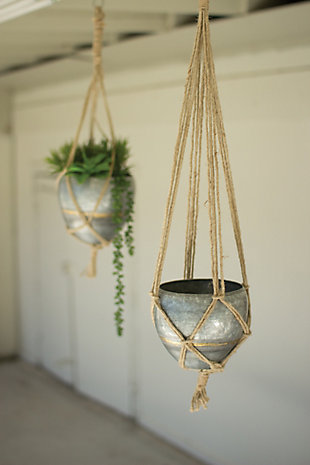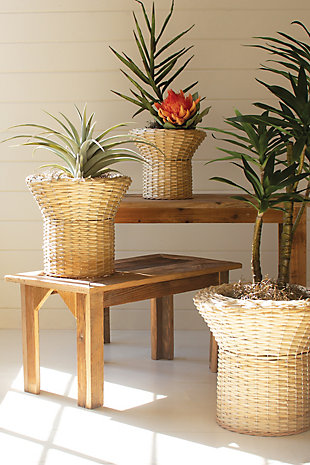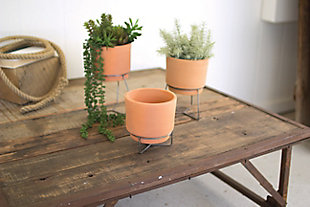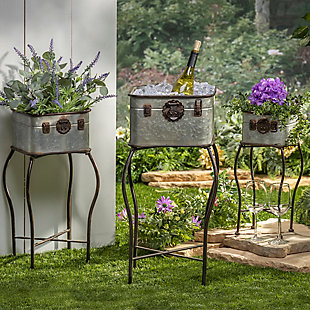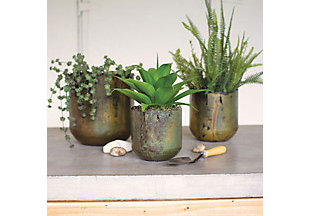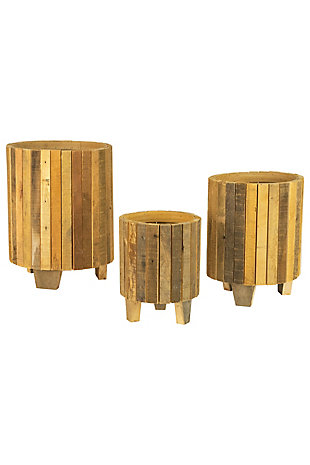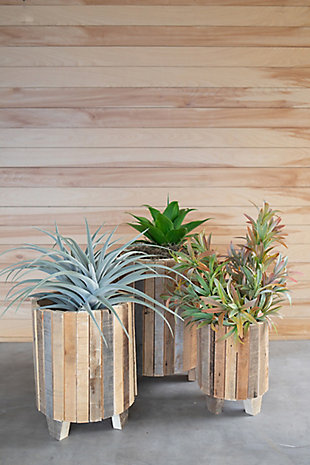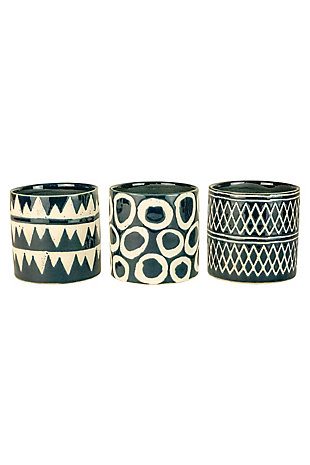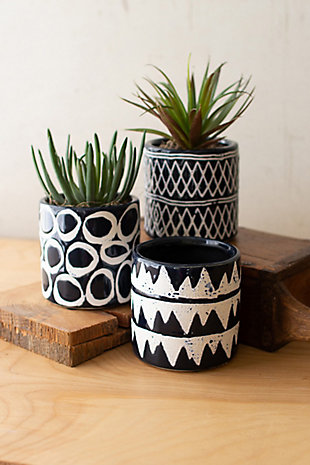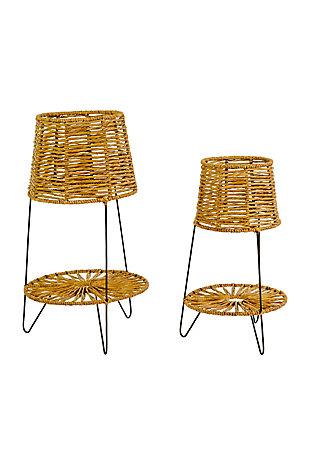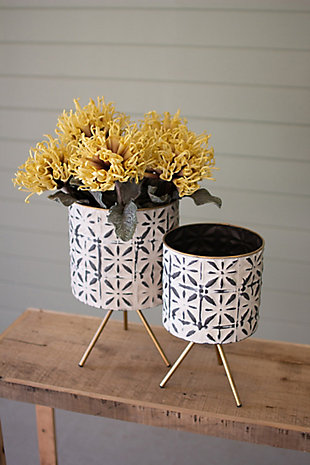-
EVENT FEATURED
- Hand woven in haiti
- Set of 2
- Due to the one of a kind nature of the product, each one may vary
- Dust regularly, wipe with damp cloth as needed
$109.99FREEGround Shipping- Delivered to your door
- Assembly may be required
- Excludes Alaska & Hawaii
Online Only!Online Only
- Items sold online only
- Not available in-store
-
- Galvanized finish
- Set of 2
- Natural jute hanging rope
- Dust regularly, wipe with damp cloth as needed
$63.99show moreFREEGround Shipping- Delivered to your door
- Assembly may be required
- Excludes Alaska & Hawaii
Online Only!Online Only
- Items sold online only
- Not available in-store
-
- Large: 17" x 16"d, medium: 14"d x 13"t; small: 12"d x 11"t
- Color: natural
- Made of rattan
- Natural finish
- Planter
$129.99show moreFREEGround Shipping- Delivered to your door
- Assembly may be required
- Excludes Alaska & Hawaii
Online Only!Online Only
- Items sold online only
- Not available in-store
-
EVENT FEATURED
- Handmade
- Set of 3
- 3 different styles and heights of stands
- Dust regularly, wipe with damp cloth as needed
- Pots are the same size
$65.99FREEGround Shipping- Delivered to your door
- Assembly may be required
- Excludes Alaska & Hawaii
Online Only!Online Only
- Items sold online only
- Not available in-store
-
EVENT FEATURED
- Made of metal
- Set of 3 classically-styled plant holders with stands
- Set comes in three sizes: large stand is 13.38inl by 27.75inh, medium stand is 11.02inl by 23.22inh, and small stand is 8.46inl by 19.29inh
- Artfully-crafted with galvanized metal, these planters are square with antique metal latches affixed to the front
- Artfully-crafted with galvanized metal, these planters are square with antique metal latches affixed to the front
$127.99FREEGround Shipping- Delivered to your door
- Assembly may be required
- Excludes Alaska & Hawaii
Online Only!Online Only
- Items sold online only
- Not available in-store
-
EVENT FEATURED
- Indoor or outdoor
- Set of 2
- Use with faux or real potted plants
- Dust regularly, wipe with damp cloth as needed
$63.99FREEGround Shipping- Delivered to your door
- Assembly may be required
- Excludes Alaska & Hawaii
Online Only!Online Only
- Items sold online only
- Not available in-store
-
- Antiqued finish
- Set of 3
- Use with faux botanica
- Dust regularly, wipe with damp cloth as needed
$116.99show moreFREEGround Shipping- Delivered to your door
- Assembly may be required
- Excludes Alaska & Hawaii
Online Only!Online Only
- Items sold online only
- Not available in-store
-
- Galvanized finish
- Set of 3
- Use with faux or real potted plants
- Dust regularly, wipe with damp cloth as needed
$151.99
or Special Financing Options Available Learn How Based on retail price of $151.99 (sales & promotions excluded)
show moreFREEGround Shipping- Delivered to your door
- Assembly may be required
- Excludes Alaska & Hawaii
Online Only!Online Only
- Items sold online only
- Not available in-store
-
- Handmade
- Set of 3
- Recycled wood
- Dust regularly, wipe with damp cloth as needed
$129.99show moreFREEGround Shipping- Delivered to your door
- Assembly may be required
- Excludes Alaska & Hawaii
Online Only!Online Only
- Items sold online only
- Not available in-store
-
EVENT FEATURED
- Indoor or outdoor
- Set of 3
- Use with faux or real potted plants
- Dust regularly, wipe with damp cloth as needed
$49.99FREEGround Shipping- Delivered to your door
- Assembly may be required
- Excludes Alaska & Hawaii
Online Only!Online Only
- Items sold online only
- Not available in-store
-
- Large: 13"d x 30"t, small: 13.5"d x 24"t
- Color: natural
- Made of seagrass and iron
- Natural finish
- Plant stand
$173.99
or Special Financing Options Available Learn How Based on retail price of $173.99 (sales & promotions excluded)
show moreFREEGround Shipping- Delivered to your door
- Assembly may be required
- Excludes Alaska & Hawaii
Online Only!Online Only
- Items sold online only
- Not available in-store
-
- Whitewashed finish
- Set of 2
- Use with faux or real potted plants
- Dust regularly, wipe with damp cloth as needed
$92.99show moreFREEGround Shipping- Delivered to your door
- Assembly may be required
- Excludes Alaska & Hawaii
Online Only!Online Only
- Items sold online only
- Not available in-store
-
EVENT FEATURED
- Set of 2
- Made of solid cast aluminum and iron
- Goldtone finish on pots
- Black finish on stand
$178.99
or Special Financing Options Available Learn How Based on retail price of $178.99 (sales & promotions excluded)
FREEGround Shipping- Delivered to your door
- Assembly may be required
- Excludes Alaska & Hawaii
Online Only!Online Only
- Items sold online only
- Not available in-store
-
- Large 8" x 4" x 8"t , medium 6.5" x 3.5" x 7.5", small 6.5" x 3" x 6"
- Color: multi
- Made of ceramic
- Glazed finish
- Decor, planter
$72.99show moreFREEGround Shipping- Delivered to your door
- Assembly may be required
- Excludes Alaska & Hawaii
Online Only!Online Only
- Items sold online only
- Not available in-store
-
- Pressed metal
- Set of 2
- Wooden stands
- Dust regularly, wipe with damp cloth as needed
$239.99
or Special Financing Options Available Learn How Based on retail price of $239.99 (sales & promotions excluded)
show moreFREEGround Shipping- Delivered to your door
- Assembly may be required
- Excludes Alaska & Hawaii
Online Only!Online Only
- Items sold online only
- Not available in-store
-
- Large 10"d x 28"t, s 8.5"d x 21"t
- Color: brown/black
- Made of metal
- Distressed white finish
- Planter
$103.99show moreFREEGround Shipping- Delivered to your door
- Assembly may be required
- Excludes Alaska & Hawaii
Online Only!Online Only
- Items sold online only
- Not available in-store
Frequently Asked Outdoor Planter Questions
Outdoor planters help turn your patio, balcony, porch, or yard into a vibrant yet cozy oasis for relaxing on your own or with friends and family. Whether your outdoor planters hold vegetables, shrubs, vines, or flowers, consider these few things to make sure they last longer and your plants thrive.Types of Outdoor Planters
Outdoor plant pots come in a variety of materials, including metal, terracotta, ceramic, concrete, hardwood, and low-density polyethylene. They also range in size and height. Small planters, perfect for creating an herb garden in outdoor wall planters, are 8 inches or less in diameter. Medium outdoor planters are about 8 to 14 inches in diameter. Large outdoor planters are about 14 to 22 inches in diameter, and extra-large outdoor planters are 22 inches or more in diameter, ideal for several types of vegetables.Group planters of different sizes for a display, or choose matching outdoor plant pots to create a cohesive look for a pathway or border. Large outdoor plant pots can provide a focal point if they hold a hibiscus or a ficus, for instance. They also can act as a privacy screen when holding trimmed shrubs or bushes such as azaleas.
Plant stands, outdoor planter boxes, urns, outdoor wall planters, railing planters, and outdoor plant hangers give you even more options for displaying cheerful pops of mums and petunias, eclectic succulents, and vines.
Choosing the Best Material for Your Outdoor Planters
When choosing decorative outdoor planters, you want a good match for the size and type of each plant and your climate. Gardening experts say outdoor plant pots should be two or three inches larger in diameter than the pot where your plant currently grows to give its roots room.A planter also needs drainage holes, which you can add yourself in polyethylene or wood. The soil in planters needs watering more often in hot weather, but you don't want your poor plants to get waterlogged!
Keep this drainage in mind as you arrange your planters. You'll douse any seating next to hanging plant pots, for instance, whenever you water those plants. Sun-loving plants and those that need infrequent watering grow best in these planters, but these outdoor plant pots can become heavy, so be sure that your hanging hardware is sturdy.
How to Care for Outdoor Planters
Some outdoor planters need a little extra TLC. Because the soil in planters freezes more readily, terracotta and ceramic planters can crack. Bring these inside during harsh weather, or choose materials such as polyethylene, which resists cracking in cold temperatures and from UV rays.Metal planters such as gold and silver make for unique outdoor decor, but these materials might not weather well. You'll likely need to freshen these up sooner.
Lastly, watch out for your surfaces. Terracotta and other clay planters can be more porous than others, so to protect a patio table or other surface from water rings, use ceramic or plastic saucers instead.


